
A roller coaster is a type of amusement ride employing a form of elevated railroad track that carries passengers on a train through tight turns, steep slopes, and other elements usually designed to produce a thrilling experience. Trains consist of open cars connected in a single line, and the rides are often found in theme parks around the world. Roller coasters first appeared in the 17th century, and LaMarcus Adna Thompson obtained one of the first known patents for a roller coaster design in 1885, based on the Switchback Railway which opened a year earlier at Coney Island.

A wooden roller coaster is a type of roller coaster classified by its wooden track, which consists of running rails made of flat steel strips mounted on laminated wood. The support structure is also typically made of wood, but may also be made of steel lattice or truss, which has no bearing on a wooden coaster's classification. The type of wood often selected in the construction of wooden coasters worldwide is southern yellow pine, which grows abundantly in the southern United States, due to its density and adherence to different forms of pressure treatment.

Bolliger & Mabillard, officially Bolliger & Mabillard Consulting Engineers, Inc. and often abbreviated B&M, is a roller coaster design consultancy based in Monthey, Switzerland. The company was founded in 1988 by engineers Walter Bolliger and Claude Mabillard, both of whom had worked for Giovanola.
A brake run on a roller coaster is any section of track that utilizes some form of brakes to slow or stop a roller coaster train. There are various types of braking methods employed on roller coasters, including friction brakes, skid brakes, and magnetic brakes. The most common is a fin brake, an alternative name for a friction brake, which involves a series of hydraulic-powered clamps that close and squeeze metal fins that are attached to the underside of a coaster train. Roller coasters may incorporate multiple brake runs throughout the coaster's track layout to adjust the train's speed at any given time.
A side friction roller coaster is an early roller coaster design invented by Edward Joy Morris. The design introduced side-friction wheels to help prevent trains from derailing during curved portions of the track. In addition to weight-bearing wheels traditionally located on the underside of each train car, friction wheels were added to both sides, which roll perpendicular along the inner edge of the track.
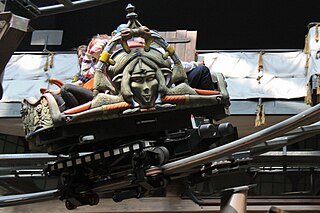
A spinning roller coaster is a roller coaster with cars that rotate on a vertical axis.
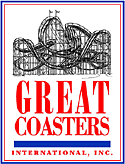
Great Coasters International, Inc. is a Sunbury, Pennsylvania-based roller coaster manufacturer which has created several award-winning rides since its formation in 1994. Starting in 2006 with Thunderbird at PowerPark in Finland, the company expanded beyond the United States and began building coasters in Europe and Asia. Günter Engelhardt GmbH handles the company's marketing rights in Europe. In addition to building new roller coasters, GCI also refurbishes and re-tracks existing roller coasters, regardless of manufacturer.

Leap-The-Dips is a wooden roller coaster located at Lakemont Park near Altoona, Pennsylvania. Built in 1902 by the Federal Construction Company and designed by E. Joy Morris, it is the oldest standing roller coaster in the world and believed to be the last surviving side friction roller coaster of the figure-eight variety.

American Coaster Enthusiasts (ACE) is a non-profit organization focusing on the enjoyment, knowledge, and preservation of roller coasters as well as recognition of some as architectural and engineering landmarks. Dues-paying members receive the quarterly magazine RollerCoaster! and bi-monthly newsletter ACE News. Amusement parks have also invited members to exclusive ride events at amusement parks as well as sneak peek events at new roller coasters under construction.
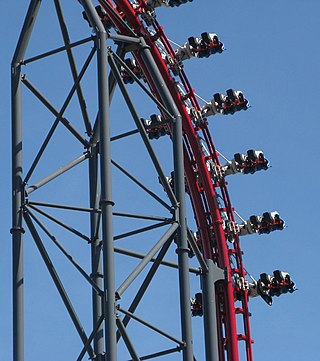
A fourth-dimension roller coaster is a type of steel roller coaster where riders are rotated independently of the track's orientation about a horizontal axis perpendicular to the track. This feature allows riders to experience inversions without the track rotating upside down. Some fourth-dimension roller coasters are controlled, with seats that rotate based on the spacing of two additional rails on the track. Others are free-spinning, where the seats flip primarily due to forces exerted by the ride's elements, offering a different experience during each ride.

Medusa, formerly known as Bizarro, is a steel roller coaster located at Six Flags Great Adventure in Jackson Township, New Jersey. Manufactured by Bolliger & Mabillard, the ride debuted as the world's first floorless roller coaster on April 2, 1999. It was repainted and rethemed to Bizarro in 2009. In 2022, it was repainted and renamed back to Medusa.

American Eagle is a wooden racing roller coaster located at Six Flags Great America theme park in Gurnee, Illinois. It was the first wooden roller coaster designed by Intamin of Switzerland and was built in 1981 by the contracting firm Figley-Wright at a cost of $10 million. While most of the records have since been broken, American Eagle had the longest drop and fastest speeds among wooden roller coasters when it debuted and is still recognized as a top racing coaster in the United States.

The Suspended Looping Coaster is a model of steel inverted roller coaster built by Dutch manufacturer Vekoma. There are at least 39 different installations across the world. The minimum rider height requirement is 130 centimetres. Vekoma is now marketing a Suspended Thrill Coaster as a successor to the Suspended Looping Coaster. The Odyssey is the largest, fastest and tallest SLC ever built at Fantasy Island in the UK.

The Wild One is a wooden roller coaster at Six Flags America in Prince George's County, Maryland. It features a 450° spiral helix and a series of bunny hills that produce a significant amount of air time. The wooden coaster was previously known as Giant Coaster when it was located at Paragon Park in Hull, Massachusetts. It operated there from 1917 to 1984. It is the oldest coaster in any Six Flags park.

Lakemont Park is an amusement park located in Altoona, Pennsylvania. The park opened in 1894 as a trolley park and became an amusement park in 1899. It is one of only thirteen trolley parks still operating, and the 8th oldest amusement park in the United States. The park was closed from 2017 to 2018, but re-opened in summer 2019. It closed for the 2024 season.
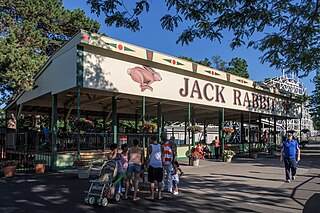
Jack Rabbit is an "out and back" wooden roller coaster located at Seabreeze Amusement Park in Irondequoit, New York. The Jack Rabbit is a terrain coaster that features seven dips, a helix, and a tunnel. It opened on May 31, 1920. Jack Rabbit is the fourth oldest operating roller coaster in the world and the second oldest in the United States. The oldest, Leap-The-Dips in Altoona, Pennsylvania, was closed from 1985 to 1999, making Jack Rabbit the oldest continuously operating coaster in the country.

Skyliner is a wooden roller coaster located at Lakemont Park in Altoona, Pennsylvania. It first opened in 1960 at New York's Roseland Park, and was John C. Allen's first full-size coaster design. Roseland Park closed in 1985, and following the success Knoebels had in relocating wooden coaster Phoenix, Lakemont Park followed suit. Skyliner reopened at Lakemont Park in 1987 after being moved from Roseland Park. Skyliner is an ACE Coaster Classic. The ride is not operating for the 2024 season.
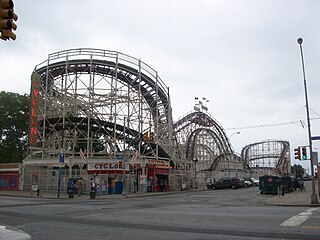
Roller coaster amusement rides have origins back to ice slides constructed in 18th-century Russia. Early technology featured sleds or wheeled carts that were sent down hills of snow reinforced by wooden supports. The technology evolved in the 19th century to feature railroad track using wheeled cars that were securely locked to the track. Newer innovations emerged in the early 20th century with side friction and underfriction technologies to allow for greater speeds and sharper turns. By the mid-to-late 20th century, these elements intensified with the introduction of steel roller coaster designs and the ability to invert riders.
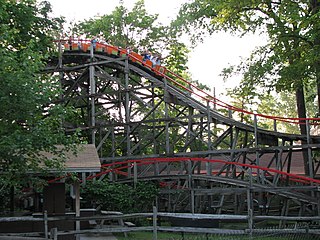
Comet is a wooden roller coaster located at Waldameer & Water World in Erie, Pennsylvania. It was designed by Herbert Schmeck and built by Philadelphia Toboggan Coasters in 1951. It is similar to other Schmeck-designed PTC junior wooden coasters which feature a layered, figure-8/oval layout. However, Comet is taller than the previous junior wooden coaster designs. Comet is an ACE Coaster Classic.

















